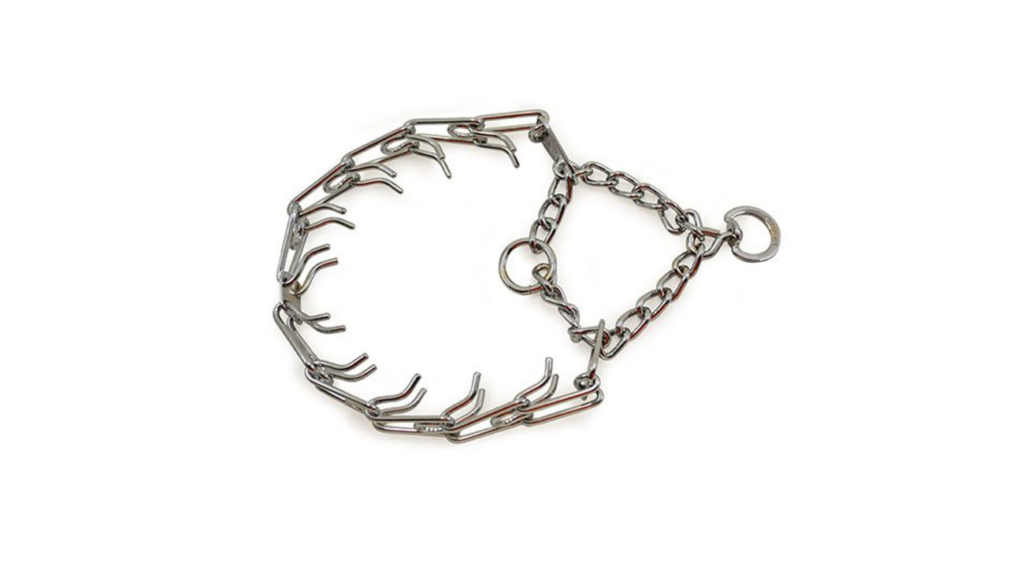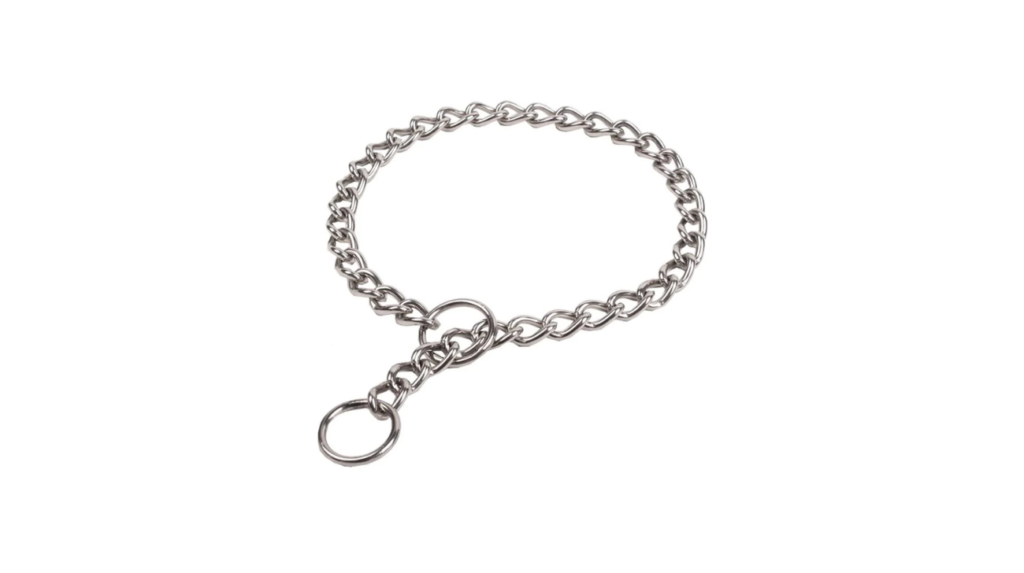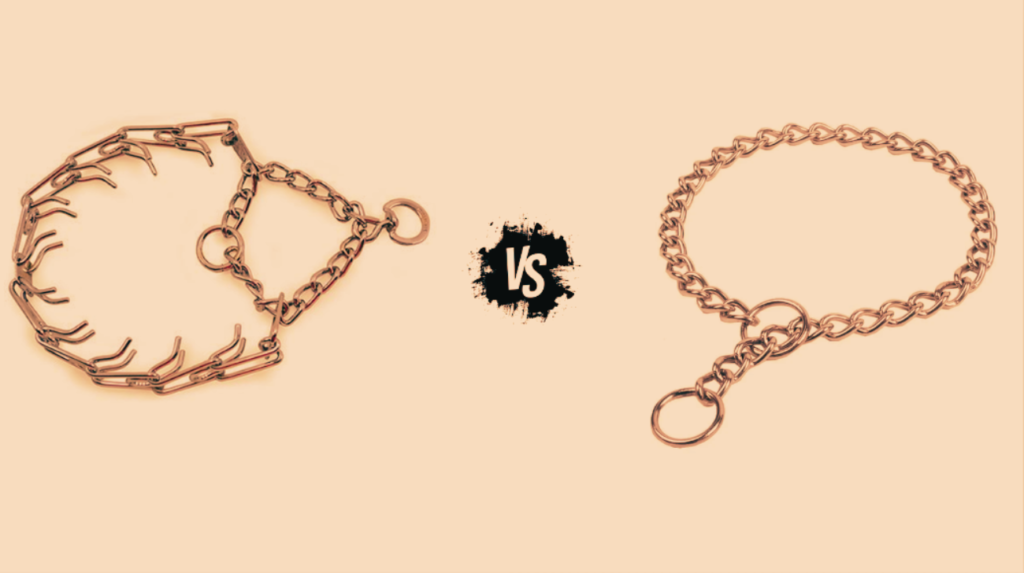Dog training can be challenging, especially when managing unwanted behaviors such as dog pulling or jumping. The right training collar can make the process smoother and more effective. Two widely discussed options are the prong collar vs choke chain.
Both tools aim to correct behavior through applied pressure, but their design, effectiveness, and safety considerations vary significantly. For expert tips on how to fit a collar on a Belgian Shepherd, this guide offers simple steps to ensure your dog’s collar fits securely and comfortably.
I’ll explore the differences between prong collars and choke chains, their benefits, potential drawbacks, and tips on using them safely and effectively. With this information, you can make an informed decision based on your dog’s specific needs.
| My Personal Opinion I find prong collars more effective and humane for managing strong or stubborn dogs, as they distribute pressure evenly and provide immediate feedback. However, choke chains can work for experienced handlers managing dogs with mild pulling tendencies. The key is proper use—misusing either tool can harm your dog. |
Blog Highlights
ToggleWhat Is a Prong Collar?
A prong collar, often referred to as a pinch collar, is a metal training collar designed with evenly spaced, inward-facing prongs. When a dog pulls or exhibits undesirable behavior, the prongs gently pinch the neck, mimicking the natural corrections dogs receive from their pack leaders or mothers.

Key Features of the Prong Collar:
- Inward-Facing Prongs: Provide even pressure around the neck.
- Adjustable Fit: Links can be added or removed for a customized fit.
- Safety Mechanism: Reduces choking risks by distributing pressure evenly.
Benefits of the Prong Collar:
- Effective for Strong Pullers: Especially useful for large, powerful breeds that are difficult to control with standard collars.
- Even Pressure Distribution: Ensures that the correction is gentle and non-damaging.
- Precise Corrections: Provides clear, immediate feedback for training purposes.
- Durability: Made from high-quality metal, ensuring longevity even with regular use.
Limitations of the Prong Collar:
- Requires Proper Handling: Misuse or improper fitting can lead to discomfort or injury.
- Not Suitable for All Dogs: Unsuitable for puppies, small breeds, or dogs with neck or respiratory issues.
- Potential Negative Perception: Some people view prong collars as harsh or inhumane.
When to Use a Prong Collar:
- For large or strong dogs that pull excessively on the leash.
- When training a dog with ingrained behavioral issues.
- If you have experience with training tools or guidance from a professional trainer.
For detailed guidance on selecting the correct collar size for a Belgian Shepherd, this article provides essential tips to ensure your dog’s comfort and safety.
What Is a Choke Chain?
A choke chain, also known as a slip chain, is a continuous metal loop that tightens around a dog’s neck when tension is applied to the leash. It works by applying and releasing pressure to signal corrections to the dog.

Key Features of the Choke Chain:
- Simple Design: A single metal chain that forms a slip loop.
- Tightening Mechanism: Tightens when the dog pulls and loosens when they stop.
- Customizable Size: Available in various lengths to suit different breeds.
Benefits of the Choke Chain:
- Affordable and Accessible: Widely available and cost-effective.
- Versatility: Can be used for basic leash training or mild corrections.
- Simple to Use: Minimal adjustment required once fitted.
- Lightweight: Suitable for dogs of various sizes when appropriately chosen.
Limitations of the Choke Chain:
- High Risk of Injury: Can cause tracheal damage or neck injuries if overused or improperly fitted.
- Less Control: Does not distribute pressure evenly, leading to discomfort.
- Timing Required: Handlers need precise timing to apply and release pressure correctly.
- Not Ideal for Stubborn Dogs: Less effective for dogs that require stronger corrections.
When to Use a Choke Chain:
- For dogs with minor pulling issues.
- When basic leash training is needed.
- If you have experience with timing leash corrections effectively.
Discover the perfect collar size for an Anatolian Shepherd Dog to ensure comfort and security for your furry friend.
Comparing Prong Collar vs Choke Chain: What Sets Them Apart?
While both tools are designed for behavior correction, their differences in design, function, and application make them suitable for distinct scenarios. Learn more about the unique double-layered coat of an Anatolian Shepherd and how to care for it effectively.
Detailed Differences Between Prong Collar vs Choke Chain
When deciding between a prong collar and a choke chain, understanding their design, functionality, and impact on your dog is essential. Below, we delve deeper into the specific differences between these tools to help you make an informed choice.

1. Design and Structure
Prong Collar:
- Made up of interlinked metal segments, each with inward-facing prongs. These prongs apply pressure evenly around the dog’s neck when tension is applied.
- The design mimics the natural corrective action a mother dog would use on her puppies, offering a humane method of communication.
- Many prong collars come with additional features such as quick-release mechanisms for safety and rubber-tipped prongs for added comfort.
Choke Chain:
- Composed of a single chain loop that tightens around the dog’s neck when pulled. The pressure is concentrated on the throat and trachea, making it less even compared to a prong collar.
- Lacks safety mechanisms, meaning it will continue tightening as long as tension is applied, which can lead to choking or injury if misused.
- Lightweight and simplistic in design, often made from metal or nylon for cost-effectiveness.
Key Difference: The prong collar offers more controlled and evenly distributed pressure, whereas the choke chain concentrates pressure on the neck, which can be harsh and potentially harmful.
For insights on whether Pomeranians should wear a collar, including considerations for safety and alternatives, check out this informative article.
2. Control and Effectiveness
Prong Collar:
- Designed for precise control, especially for strong pullers or large dogs. The prongs provide clear, immediate feedback, discouraging undesirable behavior.
- Effective for ingrained pulling habits or situations requiring quick, clear communication with the dog.
- Suitable for dogs with stubborn tendencies, as the pressure is firm but not excessive when used correctly.
Choke Chain:
- Relies on the handler’s timing and technique to deliver effective corrections. Improper timing can confuse the dog and make the tool less effective.
- Often less effective for strong pullers, as dogs may continue pulling despite the discomfort.
- Best suited for dogs with milder behavior issues or for handlers skilled in using correction-based training tools.
Key Difference: Prong collars offer more precise corrections and are better suited for larger or stronger dogs, while choke chains require expert timing and are less effective for persistent pullers. For a comprehensive guide on what kind of harness is best for a Pomeranian, including comfort and safety tips, check out this article.
3. Comfort and Safety
Prong Collar:
- Provides even pressure distribution around the neck, minimizing the risk of injury when used correctly.
- Often includes features such as rubber-tipped prongs or adjustable links to improve comfort.
- Misuse, such as excessive pulling or improper fit, can cause discomfort or injury but is less likely to lead to choking.
Choke Chain:
- Tightens indefinitely when pulled, which can put excessive pressure on the trachea, leading to choking or injury.
- Offers no safety mechanisms to limit how tightly it can constrict, making it riskier for inexperienced handlers.
- Can cause long-term damage to the dog’s neck, throat, or respiratory system if used incorrectly.
Key Difference: Prong collars are generally safer and more comfortable due to their controlled design, whereas choke chains carry a higher risk of injury, particularly when misused. Discover if the American Eskimo is a guard dog and learn about its suitability for protecting your home.
4. Training Effectiveness
Prong Collar:
- Ideal for advanced training, particularly for dogs with ingrained behavior issues such as pulling, lunging, or ignoring commands.
- Provides consistent corrections that are easy for the dog to understand and associate with undesired behavior.
- Effective for teaching leash manners and obedience in a controlled, humane way when combined with positive reinforcement techniques.
Choke Chain:
- Can be effective for dogs that respond to light, quick corrections, but requires precise timing from the handler.
- Less effective for dogs that are persistent pullers or have ingrained behavior problems, as they may ignore the pressure.
- More suited for mild behavior correction rather than severe training needs.
Key Difference: The prong collar is more effective for persistent behavioral issues and provides clearer communication, while the choke chain relies heavily on the handler’s skill and timing for effectiveness. Learn about the size collar for an American Eskimo to ensure a perfect fit and comfort for your dog.
5. Durability and Adjustability
Prong Collar:
- Made from durable materials such as stainless steel, making it resistant to wear and tear.
- Adjustable by adding or removing links, ensuring a perfect fit for dogs of various sizes.
- Often built to last, making it a good long-term investment for training purposes.
Choke Chain:
- Typically made of metal or nylon, which may wear down over time with frequent use.
- Limited adjustability; the size must be chosen carefully, as an improper fit can lead to inefficacy or harm.
- More affordable than prong collars but may need frequent replacement due to material degradation.
Key Difference: Prong collars are more durable and adjustable, offering a longer-lasting and customizable solution compared to choke chains.
6. Safety Risks
Prong Collar:
- Risks include minor discomfort or skin irritation if improperly fitted or used excessively.
- Safer for dogs with respiratory issues as it avoids focusing pressure on the throat.
- Generally lower risk of injury compared to a choke chain, provided it is used responsibly.
Choke Chain:
- High potential for choking, tracheal injury, or even psychological stress due to its tightening mechanism.
- Can lead to long-term physical damage if misused or overused.
- Requires constant supervision and expertise to prevent harm, making it a less forgiving tool for novice handlers.
Key Difference: Prong collars are safer overall, while choke chains carry significant risks if not used with care and precision. Discover why Afghan Hound collars are wide by exploring the unique characteristics of this breed and how wide collars enhance their comfort and style.
7. Cost and Accessibility
Prong Collar:
- Typically more expensive due to its complex design and durable materials.
- Requires careful consideration and possibly guidance from a professional trainer to ensure proper use.
Choke Chain:
- Affordable and widely available, making it accessible to most dog owners.
- Easier to find in stores or online, but lower cost often comes at the expense of durability and safety features.
Key Difference: Choke chains are more affordable and accessible but lack the sophistication and safety features of a prong collar.
8. Best for Specific Dog Types
Prong Collar:
- Best suited for strong pullers, large breeds, and dogs with ingrained leash-pulling habits.
- Ideal for stubborn dogs requiring immediate and firm corrections.
- Effective for dogs undergoing advanced obedience training or those needing precise control.
Choke Chain:
- More appropriate for mild pullers or dogs that respond to light corrections.
- Suitable for medium-sized dogs with moderate training needs.
- Not recommended for strong pullers, puppies, or small breeds due to safety concerns.
Key Difference: Prong collars cater to larger, more challenging dogs, while choke chains are better suited for moderate pullers with less demanding training needs. Find out what style dog collar is best for hounds to ensure comfort and safety for your furry friend.
Using the Tools Safely: Essential Tips
How to Fit a Prong Collar:
- Choose the Right Size: Ensure the collar fits snugly but comfortably around your dog’s neck.
- Position Correctly: Place it high on the neck, just behind the ears.
- Check the Fit Regularly: Remove or add links to maintain proper tension.
- Avoid Prolonged Use: Use the collar only during training sessions.
How to Fit a Choke Chain:
- Select the Right Length: The chain should slip on easily but not hang loosely.
- Position Correctly: Place it at the top of the neck for better control.
- Use Quick Corrections: Pull and release promptly to avoid prolonged tightening.
- Monitor for Discomfort: Watch for signs of coughing or difficulty breathing.
Safety Considerations
Both collars can be effective training tools when used responsibly. However, misuse or prolonged application can harm your dog.
- Avoid Excessive Force: Never yank or pull excessively, as this can cause pain or injury.
- Train with Professional Guidance: Consult a certified dog trainer to ensure proper usage.
- Monitor Your Dog: Watch for signs of stress, discomfort, or fear.
- Pair with Positive Reinforcement: Use treats and praise to encourage good behavior.
When to Use and When Not to Use: Prong Collar
When to Use and When Not to Use: Choke Chain
Alternatives to Prong Collars and Choke Chains
If you’re uncomfortable using these tools, several alternatives can help with training:
- Martingale Collars: Provide gentle corrections without the risk of choking.
- Front-Clip Harnesses: Reduce pulling by redirecting the dog’s movement.
- Head Halters: Offer control over the dog’s head, discouraging pulling.
- Standard Flat Collars: Combine with positive reinforcement techniques.
Wrapping Up
Choosing between a prong collar vs choke chain ultimately depends on your dog’s needs, behavior, and your training experience. Prong collars offer better control and safety for strong, stubborn dogs, while choke chains are suitable for mild corrections.
Regardless of your choice, proper fitting, responsible handling, and pairing with positive reinforcement are crucial for successful training. The ideal size collar for English Springer Spaniel typically ranges from 14 to 20 inches, depending on the dog’s age and neck size, ensuring a comfortable and secure fit.
Always prioritize your dog’s comfort and safety, and consult a professional trainer if you’re unsure. With patience and the right tools, you’ll guide your furry companion toward better behavior and a stronger bond.








